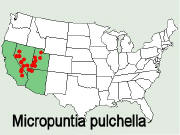|
|
Scientific Name: Micropuntia barkleyana
Daston
(1946)
Published in:
Amer. Midl. Nat. 36 (3): 661(1946)
Conservation status: Listed in
CITES appendix 2.
Common Names: Sand cholla,
Dwarf Cholla, Sand club-cholla, beautifull cholla
 Distribution
range of Micropuntia pulchella:
Northern Mojave Desert from eastern California (Deep Springs
Valley) to southern Utah and
Nevada (Churchill,
Douglas, Esmeralda, Lander, Lincoln, Mineral, Nye, Pershing, and Washoe
counties) and Arizona. Elevation : 1100-1900
meters. Distribution
range of Micropuntia pulchella:
Northern Mojave Desert from eastern California (Deep Springs
Valley) to southern Utah and
Nevada (Churchill,
Douglas, Esmeralda, Lander, Lincoln, Mineral, Nye, Pershing, and Washoe
counties) and Arizona. Elevation : 1100-1900
meters.
Habitat : "Sand Mountain,
Sand of dunes, dry-lake borders, river bottoms,
washes, valleys, sandy to rocky flats or slopes, and plains in the
desert.
Mainly on sandy
soils but also found in a
variable range of soil types
"
Synonyms:
- Grusonia pulchella
(Engelmann) Robinson,
Published in: Phytologia 26 (3): 176 (1973)
- Opuntia pulchella Engelmann,
Published in: Trans. St. Louis Acad. 2:
201(1863)
- Corynopuntia pulchella
(Engelmann) Knuth in Backeberg & Knuth,
Published in: Kaktus-ABC 115 (1935)
- Micropuntia pulchella
(Engelmann) M.P. Griffith,
Published in: Haseltonia 9:91 (2002)
- Micropuntia barkleyana Daston,
Published in:Amer. Midl. Nat. 36 (3): 661(1946)
- Opuntia barkleyana (Daston)
Rowley,
Published in: Nat. Cact. & Succ. Journ.13 (1): 5
(1958)
- Micropuntia brachyrhophalica
Daston
Published in: Amer. Midl. Nat. 36
(3):661 (1946)
- Opuntia brachyrhopalica (Daston)
Rowley
Published in: Nat. Cact. & Succ. Journ.
13 (1): 5 (1958)
- Micropuntia spectatissima
Daston,
Published in: Amer. Midl. Nat. 36 (3):661 (1946)
- Opuntia spectatissima (Daston)
Rowley
Published in: Nat. Cact. & Succ.Journ.
13 (1): 5 (1958)
- Micropuntia gracilicylindrica
Wiegand & Backeberg,
Published in: Descr. Cact.Nov. [1]: 9 (1956)
- Opuntia gracilicylindrica (Wiegand
& Backeberg) Rowley,
Published in: Nat.Cact. & Succ. Journ. 13 (1): 5
(1958)
- Micropuntia pygmaea Wiegand &
Backeberg,
Published in: Descr. Cact. Nov.[1]: 9 (1956)
- Opuntia pygmaea (Wiegand &
Backeberg) Rowley,
Published in: Nat. Cact. & Succ. Journ. 13 (1):
5 (1958)
- Micropuntia tuberculosirhophalica
Wiegand & Backeberg
Published in: Descr.Cact.
Nov. [1]: 9 (1956)
- Opuntia tuberculosirhophalica
(Wiegand & Backeberg) Rowley, Published in:
Nat.Cact. & Succ. Journ. 13 (1): 5 (1958)
- Micropuntia wiegandii
Backeberg,
Published in: Descr. Cact. Nov. [1]: 9 (1956)
- Micropuntia gigantea Wiegand
& Backeberg,
Published in: Descr. Cact. Nov.[1]: 9 (1956) pro
syn.
- Opuntia wiegandii (Backeberg)
Rowley,
Published in: Nat. Cact. & Succ.Journ. 13 (1): 5
(1958)
|
|
Description:
Attractive
mini Opuntia, forming low sub-erected shrubs more or less dense and large,
spread cushions
hiding a large
tuber
below ground.
Stem segments: Cylindric to
ellipsoid,
clavate, 1-4(-10) × 0.5-1.2(-2.5) cm; tubercles
purple tinged rather prominent, 5-9 mm;
Spines:
8-15 per areole, mostly in distal areoles
at the tip of the stem, divergent to
deflexed, red-brown or white, aging grey, somewhat
flattened,
with woolly areoles white to grey.
Flowers: rose to purple; 15-35 mm; filaments green to yellow;
style purplish; stigma lobes white to yellowish. Flowering late
spring (May-June).
Roots: The root system of young specimens is fibrous, but
will slowly enlarge to form a corky caudex with short tuberose
roots.
Fruits: Reddish
obconic to ellipsoids, 15-30 × 8-12 mm
smooth and juicy in a first time, becoming quickly dry.
|
|
|
|

A 12 years old specimen showing the characteristic corky
caudex and the tuberose root. The caudex will take several years to
develop.
Cultivation:
This plant is not easy to grow. Good resistance to the cold (-10°C) but it can't stand
humidity. Plants are susceptible to overwatering and are extremely
rot-prone. They have sensitive roots . Keep the plants away from places
with elevated humidity in the air. They need to grow in a very
ventilated and dry environment, in full sun. They need to be kept in a
cool (and dry) place during winter rest (at -5 / 10°C). This is
important for the flowers as well as for their health. Without this cool
winter period they normally won't get many buds.
Propagation: Cutting or (rarely) seeds.
Rooting of cuttings is generally difficult.
Photo of conspecific taxa, varieties, forms and
cultivars of Micropuntia pulchella .
|
|